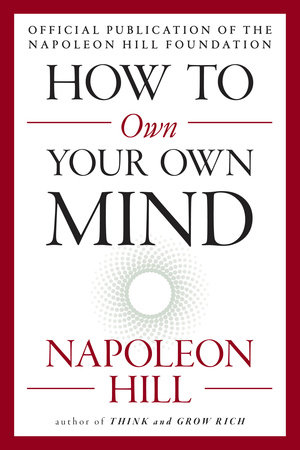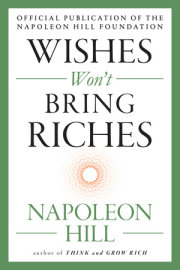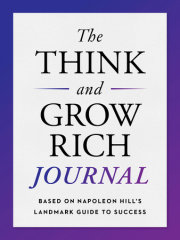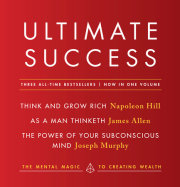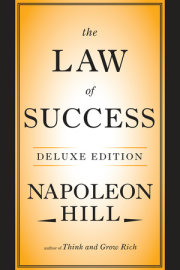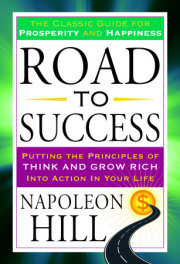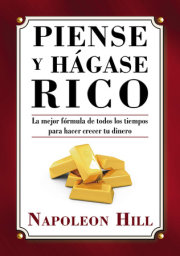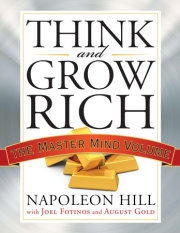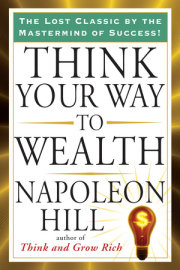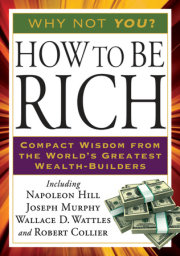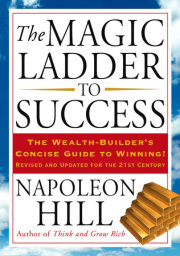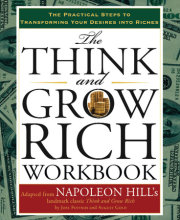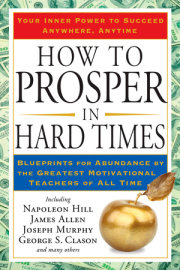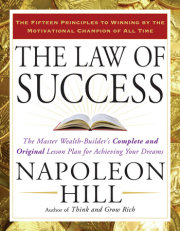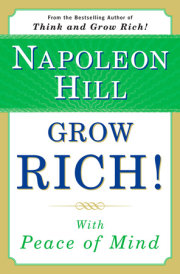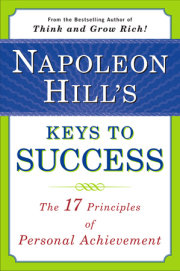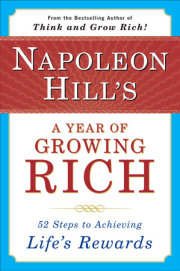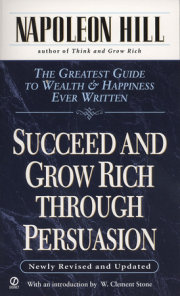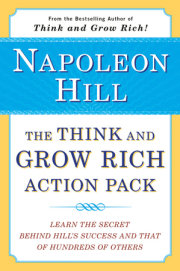Chapter One
Creative Vision
A philosopher said, "The imagination is the workshop of man wherein is fashioned the pattern of all his achievements." Another thinker described it as "the workshop of the soul wherein man's hopes and desires are made ready for material expression."
This chapter describes the methods by which some of the great leaders of America have, through the application of Creative Vision, made the American way of life the envy of the world.
This chapter begins in the private study of Andrew Carnegie in 1908, with me, Napoleon Hill, as the student and reporter.
HILL:
Mr. Carnegie, you have said that Creative Vision is one of the principles of individual achievement. Will you analyze this principle and describe how one may make practical use of it?
CARNEGIE:
First of all, let us have a clear understanding of the meaning of the term "Creative Vision," as we are here using it, by explaining that this is not merely another name for imagination. It is the ability to recognize opportunities and take action to benefit from them. An important element of Creative Vision is the use of the imagination.
There are two types of imagination. One is known as synthetic imagination and the other as creative imagination.
Synthetic imagination consists of the act of combining recognized ideas, concepts, plans, facts, and principles in new arrangements. The old axiom "There is nothing new under the sun" grew out of the fact that the majority of things which seem to be new are nothing but a rearrangement of that which is old. Practically all the patents recorded in the Patent Office are nothing more than old ideas which have been arranged in a new order, or given a new use. Patents which do not come under this heading are known as "basic patents" and they are the work of Creative Imagination; that is, they are based on newly created ideas which have not been previously used or recognized.
Creative Imagination has its source, as far as science has been able to determine, in the subconscious mind, wherein exists, through some power unknown to science, the ability to perceive and interpret new ideas. It is believed, by some, that the faculty of Creative Imagination truly is "the workshop of the soul." Of one fact we can be sure, and that is the undeniable reality of the existence of a faculty of the mind through which some men perceive and interpret new ideas never before known to man. Later I shall cite well-known examples of such ability. Moreover, I shall endeavor to describe how this ability may be developed and made to serve practical ends.
HILL:
Which of the two types of imagination is used more often in the field of industry, and in the ordinary walks of life?
CARNEGIE:
Synthetic imagination is more commonly used. Creative imagination, as the name implies, is used only by those who have attained the means to apply this unusual skill.
HILL:
Will you mention examples of the application of both types of imagination, giving as many of the details as possible in order that the practical methods of application of these principles may be understood?
CARNEGIE:
Well, let us take the work of Thomas A. Edison, for example. By studying his achievements we shall see how he made use of both types of imagination, although he used the synthetic type more often.
His first invention to attract worldwide attention was created by bringing together, in a new combination, two old and well-known principles. I refer to the incandescent electric lamp, the perfection of which was attained only after Mr. Edison had tried more than ten thousand different combinations of old ideas without satisfactory results.
HILL:
Do you mean, Mr. Carnegie, that Mr. Edison had the persistence to keep on trying in the face of ten thousand failures?
CARNEGIE:
Yes, I mean just that! And I may as well here call your attention to the fact that men with a keen sense of imagination seldom quit trying until they find the answer to their problems.
Mr. Edison perfected the incandescent electric lamp by combining two well-known principles in a new way. The first of these principles was the established fact that by applying electric energy to both ends of a piece of wire a resistance is established through which the wire becomes heated to a white glow that will produce light. That principle had been known long before the time of Mr. Edison's experiments with the electric lamp, but the trouble arose from the fact that no way had been found to control the heat. Perhaps the facts would be better understood if I said that no form of metal or other substance had been found that could carry the necessary amount of heat to make a satisfactory light for more than a few seconds. The intense heat of the electricity soon burned out the metal.
After trying every known substance he could find, without discovering anything that would serve the desired purpose, Mr. Edison stumbled upon another well-known principle which proved to be the answer to his problem. I say he "stumbled" upon it, but perhaps that is not the precise way the principle came to his attention. Of that I shall have more to say later on. At any rate, there came into his mind the well-known principle by which charcoal is produced, and he recognized in it the answer to the problem that had caused him more than ten thousand failures.
Briefly explained, charcoal is produced by placing a pile of wood on the ground, setting it on fire, and then covering the whole pile with dirt. The dirt permits just enough air to pass through to the fire to keep it alive and smoldering but not enough to enable the fire to blaze. The smoldering process continues until the wood becomes charred through and through, leaving the log intact, in the form of a substance known as charcoal.
You of course learned, in the study of physics, that where there is no oxygen there can be no fire; that by controlling the inflow of oxygen the amount of heat of the fire can be controlled proportionately.
Mr. Edison had known of this principle long before he began experimenting with the electric lamp, but not until after he had gone through thousands of tests did he think of it as being the principle for which he was searching.
As soon as this principle was recognized as the one for which he was searching, he went into his laboratory, placed a coiled wire in a bottle, pumped out all the air, sealed the bottle with wax, applied the electric energy to the two ends of the wire, and lo! the world's first successful incandescent electric lamp was born. The crudely constructed lamp burned for more than eight hours.
Of course it is obvious as to what had happened. By placing the wire in a vacuum that contained no oxygen it could be heated sufficiently to cause it to produce a light without its burning out entirely, as it had done when left in the open air. That same principle is used in the making of all incandescent electric lamps today, although the method has been greatly refined until the modern electric lamp is much more efficient than it was when Edison first discovered how to control the heat.
Now, let us go back to the question as to how Mr. Edison came to think of combining these two old principles in a new way. I said he "stumbled" upon the idea of using the charcoal principle as a means of controlling the heat of the electric energy. But that is not exactly the way this idea occurred to him.
Here begins, then, the entry into the picture of the principle of creative imagination. By his repetition of thought in connection with his problem, carried on over a long period of time, through thousands of experiments, Mr. Edison either consciously or unconsciously charged his subconscious mind with a clear picture of his problem, and, by some queer power which no one understands, his subconscious mind handed over to him the solution to his problem, in the form of a "hunch" that caused him to think of the charcoal principle.
In describing the experience many years afterward, Mr. Edison said that when the "hunch" came to him he recognized it immediately as being the missing link for which he had been searching. Moreover, he felt assured it would work, even before he tested it. He made the further significant statement that when the idea of using the charcoal principle "flashed into his mind" it brought with it a feeling of assurance of its suitability such as did not accompany any one of the other thousands of similar ideas he had tested, through synthetic imagination.
From this statement we may draw the conclusion that the subconscious mind not only has the power to create the solution to problems, but it also has a means of forcing one to recognize the solution when it is presented to the conscious mind.
WHEREVER you find a prosperous business, you will come upon some individual who has Creative Vision.
HILL:
From what you have said, Mr. Carnegie, I conclude that persistence was of the essence of Mr. Edison's discovery of the solution to his problem.
CARNEGIE:
Yes, and some other factors, too. First of all, he began his research with definiteness of purpose, thus applying perhaps the most important of the principles of individual achievement. He knew the nature of his problem, but equally as important as this, he was determined to find its solution. Therefore he backed his definiteness of purpose with an obsessional desire for its attainment. Obsessional desire is the state of mind which serves to clear the mind of fear and doubt and self-imposed limitations, thereby opening the way for that state of mind known as Faith. By his refusal to accept defeat, through more than ten thousand failures, Mr. Edison prepared his mind for the application of Faith.
HILL:
Were all of Mr. Edison's inventions created through the joint application of creative imagination and synthetic imagination, as in the case of the incandescent electric lamp?
CARNEGIE:
Oh, no! Not by any means. The majority of his inventions were created solely through the aid of synthetic imagination, by the trial-and-error method of experimentation. But he did complete one invention solely through the aid of creative imagination, and as far as I know, this was the only invention he perfected through this principle alone. I have reference to the phonograph. That was a new idea. No one before Edison, as far as is known, had ever produced a machine that would record and reproduce the vibrations of sound.
HILL:
What technique did Mr. Edison use in the application of creative imagination in perfecting the talking machine?
CARNEGIE:
The technique was very simple. He impressed his subconscious mind with the idea of a talking machine and there passed over to his conscious mind a perfect plan for the building of such a machine.
HILL:
Do you mean that Edison relied on creative imagination entirely?
CARNEGIE:
Yes, entirely! And one of the strange features of this particular invention of Mr. Edison's is the fact that the plan which his subconscious mind yielded to him worked almost from the first attempt to apply it. The idea of how such a machine could be produced "flashed" into Edison's mind. He sat down then and there and drew a rough picture of the machine, handed it to his model maker and asked him to produce the machine, and in a matter of hours it had been finished, tested, and lo! it worked. Of course the machine was crude, but it was sufficient to prove that Edison's creative imagination had not failed him.
HILL:
You say that Mr. Edison "impressed his subconscious mind" with the idea of a talking machine. Now, how did he go about doing this, and how long did it require before his subconscious mind handed over to him the working principle of the machine?
CARNEGIE:
I am not sure that Mr. Edison stated exactly how long he had been thinking of such a machine before his subconscious mind picked up his thoughts and translated them into a perfected plan, but I am under the impression it was not more than a few weeks, at most. Perhaps not more than a few days. His method of impressing his subconscious mind with his desire consisted of the simple procedure of converting that desire into an obsession. That is, the thought of a machine that would record and reproduce sound became the dominating thought of his mind. He focused his mind on it, through concentration of his interest, and made it the major occupant of his mind from day to day until this form of autosuggestion penetrated his subconscious mind and registered a clear picture of his desire.
HILL:
Is that the way one connects the conscious mind with the subconscious, Mr. Carnegie?
CARNEGIE:
Yes, that is the simplest known method. You see, therefore, why I have emphasized the importance of intensifying one's desires until they become obsessional. A deep, burning desire is picked up by the subconscious and acted upon much more definitely and quickly than an ordinary desire. A mere wish appears to make no impression on the subconscious! Many people become confused as to the difference between a wish and a burning desire which has been stimulated into obsessional proportions by the repetition of thought in connection with the desire.
HILL:
If I understand you correctly, Mr. Carnegie, the element of repetition is important. Why?
CARNEGIE:
Because repetition of thought creates "thought habits" in the mind which cause the mind to go right on working on an idea without one's conscious effort. Apparently the subconscious concerns itself first with those thoughts which have become habits and especially if the thoughts have been strongly emotionalized by a deep and burning desire for their realization.
HILL:
Then anyone may make use of creative imagination by the simple process of charging his subconscious mind with definite desires?
CARNEGIE:
Yes, there is nothing to hinder anyone from using this principle, but you must remember that practical results are obtained only by those who have gained discipline over their thought habits, through the process of concentration of interest and desire. Fleeting thoughts which come and go intermittently, and mere wishes, which are about the extent of the average person's thinking, make no impression whatsoever on the subconscious mind.
HILL:
Will you mention some additional examples of the practical application of the two types of imagination?
CARNEGIE:
Well, take the experience of Henry Ford, in connection with his perfection of a self-propelled vehicle, for example. The idea of such a vehicle was first suggested to him by a steam-propelled tractor that was being used to haul a threshing machine. From the first time that he saw the tractor his mind began to work on the idea of a horseless buggy.
Copyright © 2017 by Napoleon Hill. All rights reserved. No part of this excerpt may be reproduced or reprinted without permission in writing from the publisher.





